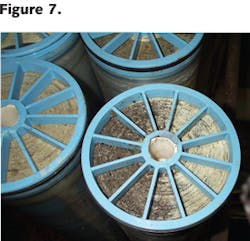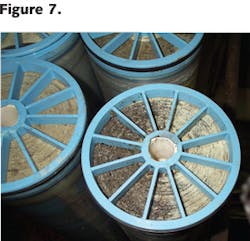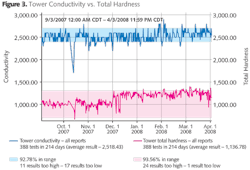With the state's initiative to reduce water usage by 20 percent by the year 2020, many plants in California are striving to become more environmentally friendly. One such facility includes a leading California hospital that sought to reduce water treatment costs for its HVAC system. The hospital has three individual cooling tower systems that service three centrifugal chillers, with a combined total of 2,800 tons of capacity.
The water treatment program currently in use at the facility was operating at 2.8 cycles of concentration, resulting in 35.7 percent of the tower water makeup being bled to the sewer by the current treatment provider. Given the water quality in the area, this was the maximum cycles of concentration that could be achieved without employing the use of acid or water softening.
The savings that the hospital sought were realized by reconsidering various ways to optimize the water treatment program. Working closely with the Los Angeles Department of Water and Power (LADWP), it was revealed that by introducing a water conservation program to reduce water use through increased cycles of concentration, the facility would actually save more money than it would spend to alter the program, making the proposed project sustainable.
Through testing and lab analysis, the team was able to conclude that six cycles of concentration could be attained, resulting in only 16.7 percent of the tower makeup water being bled into the sewer treatment system. This could be achieved through the introduction of a safe acid feed system that would minimize scale, corrosion and microbiological fouling to enable the increase in cycles of concentration while also protecting facility staff from coming into contact with the chemicals.
The evaporation of the cooling tower remained the same, but U.S. Water was able to reduce blowdown, cutting water usage by an estimated 3.6 million gallons per year and decreasing water and sewage costs. The plant was able to save over $76,000 (see Fig. 1).
Anytime chemistry in the cooling tower is stressed by adding more cycles, tight control of the chemistry is required to prevent scale formation. This led to the introduction of U.S. Water's advanced automation controls. The advanced automation program included wireless monitoring and alarm notifications to manage the overall program performance (see Fig. 2), and the equipment monitored conductivity, pH, scale inhibitor levels, tower makeup usage, and tower bleed usage.
At any given time, designated hospital personnel and U.S. Water representatives, using various levels of password-protected security outlined by the facility, can securely access the data for review and online adjustment. If designated parameters fell above or below the specified range, a U.S. Water representative was alerted for quick response (see Fig. 3).
Second to irrigation, cooling towers offer the largest potential for water savings in California. As an added incentive, the state of California has put programs in place to rebate facilities for the cost of automating their systems. LADWP and the Metropolitan Water District (MWD), for example, offer three programs that finance automation for cooling towers due to their ability to increase cycles of concentration, which reduces water use.
This financing allowed U.S. Water to implement the $34,000 advanced automation program to monitor and control the water treatment program for this hospital at no cost to the hospital.
Results to date for the facility include significant reduction in water usage, lower water and sewage bills and more efficient monitoring due to the installed automation software to protect the equipment assets.
About the Company: US Water Services (www.uswaterservices.com) provides integrated water management solutions combining engineering, equipment, chemicals, and services to help customers find optimal solutions for their most challenging water, energy and compliance problems.





